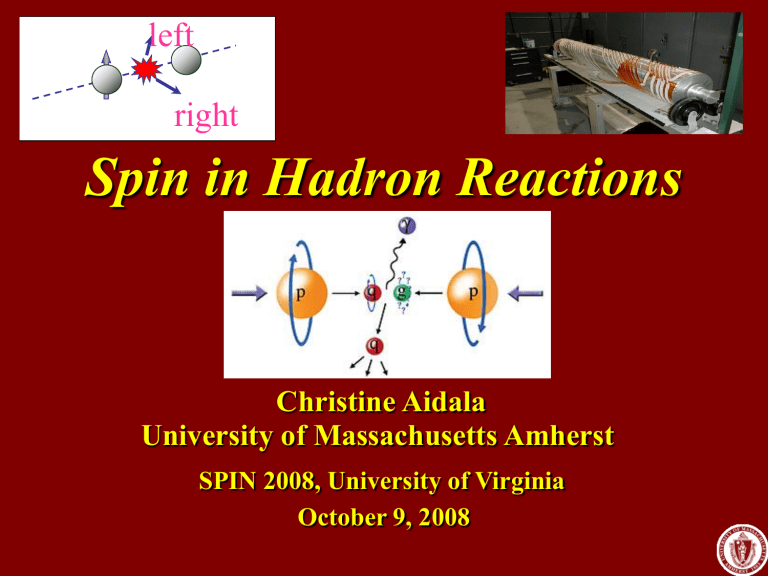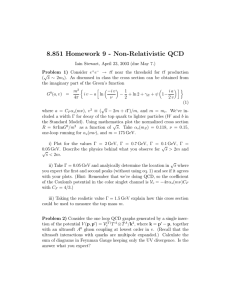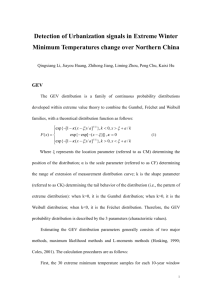Spin in Hadron Reactions left right Christine Aidala
advertisement

left right Spin in Hadron Reactions Christine Aidala University of Massachusetts Amherst SPIN 2008, University of Virginia October 9, 2008 The Relativistic Heavy Ion Collider at Brookhaven National Laboratory C. Aidala, SPIN2008, October 9, 2008 2 RHIC as a Polarized p+p Collider RHIC pC Polarimeters Absolute Polarimeter (H jet) Siberian Snakes BRAHMS & PP2PP PHOBOS Siberian Snakes Spin Flipper PHENIX STAR Spin Rotators Polarized Source Partial Snake Strong Snake LINAC 200 MeV Polarimeter Helical Partial Snake AGS BOOSTER Rf Dipole AGS Internal Polarimeter AGS pC Polarimeter C. Aidala, SPIN2008, October 9, 2008 Various equipment to maintain and measure beam polarization through acceleration and storage 3 Discovery! Hyperon polarization G. Bunce et al., PRL36, 1113 (1976) FNAL More than 30 years later, still not well understood! C. Aidala, SPIN2008, October 9, 2008 4 Polarized beams: Hyperon spin transfer measurements E704: Correlation found between transverse spin STAR of initial-state proton and final-state lambda! Spin transfers consistent PRL78, 4003 (1997) –with E704zero observed at RHIC with longitudinal polarization in the initial state. Transverse C. Aidala, SPIN2008, October 9, 2008 measurements still to come . . . 5 Discovery! Large transverse single-spin asymmetries Argonne ZGS, pbeam = 12 GeV/c pp X left right W.H. Dragoset et al., PRL36, 929 (1976) C. Aidala, SPIN2008, October 9, 2008 6 Transverse-momentum-dependent distributions and SSA’s 1989: The “Sivers mechanism” is proposed in an attempt to understand the low-energy hadronic asymmetries. D.W. Sivers, PRD41, 83 (1990) CERN C. Aidala, SPIN2008, October 9, 2008 7 Transverse SSA’s from low to high energies ZGS 12 GeV beam PRL36, 929 (1976) AGS 22 GeV beam FNAL 200 GeV beam PRD65, 092008 (2002) C. Aidala, SPIN2008, October 9, 2008 PLB261, 201 (1991) PLB264, 462 (1991) 8 Transverse SSA’s at √s = 62.4 GeV at RHIC PRL101, 042001 (2008) 0 C. Aidala, SPIN2008, October 9, 2008 9 Transverse SSA’s at √s = 200 GeV at RHIC 0 BRAHMS Preliminary arXiv:0801.2990 Accepted by PRL C. Aidala, SPIN2008, October 9, 2008 STAR10 200 GeV , K, p at 200 and 62.4 GeV 62.4 GeV Note different scales K K- asymmetries underpredicted 200 GeV p 200 GeV K 62.4 GeV Large antiproton asymmetry?? Unfortunately no 62.4 GeV measurement C. Aidala, SPIN2008, October 9, 2008 p 62.4 GeV 11 Probing the Sivers Function via Dijets • Sivers effect in p+p spin-dependent sideways boost to dijets, suggested by Boer & Vogelsang (PRD 69, 094025 (2004)) • 2005: Prediction by Vogelsang and Yuan for p+p, based on preliminary Sivers moments from HERMES proton spin y parton kTx x z W. Vogelsang and F. Yuan, PRD 72, 054028 (2005). C. Aidala, SPIN2008, October 9, 2008 12 Measured Sivers AN for Dijets STAR Measured AN consistent with zero both quark and gluon Sivers effects much smaller in p+p dijets than in HERMES SIDIS!! 13 C. Aidala, SPIN2008, October 9, 2008 Calculations for p+p revisited! Bomhof, Mulders, Vogelsang, Yuan: PRD75, 074019 (2007) Prediction for dijet SSA if Sivers contributions were same as for SIDIS (FSI) Asymmetries observed at STAR also consistent with SIDIS results! Initial- and final-state cancellations in p+p jet+jet found to reduce expected dijet asymmetry at RHIC. Prediction for dijet SSA if Sivers contributions were same as for Drell-Yan (ISI) STAR PRL99, 14003 (2007) C. Aidala, SPIN2008, October 9, 2008 14 Hadronic interactions and the helicity structure of the nucleon D 1 N / L N / L ALL | P1P2 | N / L N / L D ( pp X ) Dq( x1 ) Dg ( x2 ) Dˆ 0 DIS ? qgqg pQCD 0 ( sˆ) Dq ( z ) e+e- Leading-order access to gluons DG C. Aidala, SPIN2008, October 9, 2008 15 Inclusive jet production at 200 GeV GRSV polarized pdf fit:notPRD 63, 094005 (2001) *Theoretical uncertainties included 252001 (2006) PRL97, -0.7 < < 0.9 STARGRSV framework: Within GRSV curves with cone radius 0.7 Dg_std excluded with 99% CL and -0.7 < < 0.9Dg<-0.7 excluded with 90% CL 2005 jet data now published: PRL100, 232003 (2008) C. Aidala, SPIN2008, October 9, 2008 16 Inclusive neutral pion production at 200 GeV PRD76, 051106 (2007) arXiv:0810.0694, submitted to PRL C. Aidala, SPIN2008, October 9, 2008 17 0 ALL: Agreement with different parametrizations Small ΔG in our measured x region 0.02 to 0.3 gives small ALL (DSSV and GS-C). Large ΔG gives comparatively larger ALL . Note small ALL does not necessarily arXiv:0810.0694, submitted to PRLmean small ΔG in the full x range! 18 C. Aidala, SPIN2008, October 9, 2008 0 ALL: Agreement with different parametrizations For each parametrization, vary DG[0,1] at the input scale while fixing Dq(x) and the shape of Dg(x), i.e. no refit to DIS data. For range of shapes studied, current data relatively insensitive to shape in x region covered. Need to extend x range! arXiv:0810.0694, submitted to PRL C. Aidala, SPIN2008, October 9, 2008 19 Extending x coverage arXiv:0810.0701, submitted to PRD • Measure in different kinematic regions Extend to lower x at s = 500 GeV Extend to higher x at s = 62.4 GeV 200 GeV present x-range s = 200 GeV – e.g. forward62.4 vs. central GeV • Change center-of-mass energy – Most data so far at 200 GeV – Brief run in 2006 at 62.4 GeV – First 500 GeV data-taking planned for 2009! C. Aidala, SPIN2008, October 9, 2008 20 Neutral pion ALL at 62.4 GeV Converting to xT, can see significance of 62.4 GeV measurement (0.08 pb-1) compared to published data from 2005 at 200 GeV (3.4 pb-1). 0.02 xgluon 0.3 ( s 200 GeV) 0.06 xgluon 0.4 ( s 62.4 GeV) arXiv:0810.0701, submitted to PRD C. Aidala, SPIN2008, October 9, 2008 21 • Inclusive channels suffer from integration over x modeldependent Dg extraction Dijet ALL projections for 2009 run • Improved accelerator and detector performance will allow jet-jet and g-jet coincidence STAR measurements, placing better constraints on partonic kinematics xgluon Going beyond inclusive measurements Inclusive 0 200 500 101 GeV N.B. x-range sampled depends on Dg(x,Q2) ! -- M. Stratmann 102 0 10 20 pT (GeV) 30 xT 1 2 x e e ; x2 T e 1 e 2 2 2 2 pT xT s pp x1 C. Aidala, SPIN2008, October 9, 2008 22 Getting the full return on experimental efforts: Global analyses de Florian et al., PRL101, 072001 (2008) Just the beginning—need to perform and include in global analyses measurements with higher precision and covering a greater x range! • The first global NLO analysis to include inclusive DIS, SIDIS, and RHIC p+p data on an equal footing • Finds node in gluon distribution near x ~ 0.1 C. Aidala, SPIN2008, October 9, 2008 23 Access to flavor-separated quark and antiquark helicities via W production 1 N / L N / L AL P N / L N / L W L Du( x1 )d ( x2 ) Dd ( x1 )u( x2 ) u( x1 )d ( x2 ) d ( x1 )u( x2 ) W L Dd ( x1 )u ( x2 ) Du ( x1 )d ( x2 ) d ( x1 )u ( x2 ) u ( x1 )d ( x2 ) A V-A coupling Only L.H. u and R.H. d couple to W+ Likewise L.H. d and R.H. u to WOnly L.H. W’s produced A Aidala, SPIN2008, October 9, 2008 DSSV, PRL101, 072001C.(2008) 24 24 Sensitivity projections vs. pT •1<<2 • 300 pb-1 • Realistic BG subtraction Expect first 500 GeV collisions in 2009! • Recent PDFs ~representing STAR current allowed Du/Dd range • Dd and Du isolated C. Aidala, SPIN2008, October 9, 2008 25 25 Conclusions • Hadronic interactions have played and continue to play an integral role in the discovery and exploration of spindependent effects! • RHIC, as a high-energy polarized proton collider, represents a landmark achievement in the field, having opened up a wealth of new opportunities • Through global efforts, utilizing all the tools and techniques we have at our disposal, both theoretically and in different experimental systems, we can harness the full potential of hadronic reactions – The more we know from simpler systems, the more we can learn from increasingly complex ones! C. Aidala, SPIN2008, October 9, 2008 26 “Polarization data has often been the graveyard of fashionable theories. If theorists had their way, they might just ban such measurements altogether out of self-protection.” J.D. Bjorken NATO Advanced Research Workshop on QCD Hard Hadronic Processes St. Croix, 1987 C. Aidala, SPIN2008, October 9, 2008 27 Extra slides C. Aidala, SPIN2008, October 9, 2008 28 0 pT vs. xgluon Based on simulation using NLO pQCD as input arXiv:0810.0694, submitted to PRL C. Aidala, SPIN2008, October 9, 2008 29 Neutral pion ALL at STAR -0.95 < < 0.95 1.0 < < 2.0 STAR C. Aidala, SPIN2008, October 9, 2008 30 ALL at 200 GeV •~1/2 as abundant as π0 •40% photon branching ratio •Different wavefunction from π0 •Stronger gluon/strange C. Aidala, SPIN2008, October 9, 2008 31 The Pion Isospin Triplet, ALL and DG • At transverse momenta > ~5 GeV/c, midrapidity pions dominantly produced via qg scattering • Tendency of + (ud )to fragment from an up quark and - (du ) from a down quark and fact that Du and Dd have opposite signs make ALL of + and - differ measurably • Order of asymmetries of pion species can allow us to determine the sign of DG Fraction pions produced 0 DG 0 ALL ALL ALL C. Aidala, SPIN2008, October 9, 2008 32 Charged pion ALL at 200 GeV STAR C. Aidala, SPIN2008, October 9, 2008 33 ALL of non-identified charged hadrons at 62.4 GeV Cross section measurement in progress! 14% polarization uncertainty not included C. Aidala, SPIN2008, October 9, 2008 34 ALL of direct photons at 200 GeV C. Aidala, SPIN2008, October 9, 2008 35 ALL of J/y at s=200 GeV gg QQ J/y C. Aidala, SPIN2008, October 9, 2008 Dg Dg g g 36 xT Scaling • xT scaling—can parametrize cross sections for particle production in hadronic collisions by: d 3 E 3 ~ dp s n s 62 ~ 540GeV F ( xT ) 2 pT xT , n constant s • Lower energy has higher yield at fixed xT d 3 d 3 s L E 3 dpT L E 3 dxT dp dp 2 L s 5.3 We can probe higher xT with better statistics even with a short run at 62.4 GeV!! (compared to 200 GeV) 37 C. Aidala, SPIN2008, October 9, 2008 x pQCD in Action at s=200 GeV h h 2 STAR 0 || < 0.35 PRLpions 95, 202001 Fraction (2005) produced C. Aidala, SPIN2008, October 9, 2008 STAR ~0 38 Prompt g Production at s=200 GeV • Gluon Compton scattering dominates – At LO no fragmentation function – Small contribution from annihilation g P1 x1P1 P2 x2P2 DgDq DqDq Dg ( x1 ) Dq( x2 ) ALL aˆ LL ( gq gq) g ( x1 ) q ( x2 ) C. Aidala, SPIN2008, October 9, 2008 39 Forward Hadron Production at s=200 GeV Good agreement between data and NLO pQCD at s=200 GeV, even at larger rapidities PRL 97 (2006) 152302 STAR Fraction pions produced C. Aidala, SPIN2008, October 9, 2008 40 Change in pQCD calculation of cross section if factorization scale change by factor 2 pQCD scale dependence at RHIC ( 0 / 2) (0 ) Scale dependence benchmark: HERMES (hadron pairs) Tevatron ~ 1.2 RHIC ~ 1.3 COMPASS ~ 2.5 – 3 HERMES ~ 4 – 5 COMPASS (hadron pairs) RHIC (direct photon) E708 (direct photon) CDF (direct photon) Scale dependence at RHIC is significantly reduced compared to fixed target polarized DIS. Conclusion: Extraction of spin dependent parton distributions is possible at RHIC using perturbative QCD ab initio: First spin structure experiments at collider energies! C. Aidala, SPIN2008, October 9, 2008 41 Spin Crisis Came Out of a Low-x Measurement 1 1 D D G L Gq SLAC: 0.10 < xSLAC <0.7 2 ~20.6 Quark-Parton Model D CERN: 0.01 < xCERN <0.5 SLAC expectation! E130, Phys.Rev.Lett.51:1135 (1983) 415 citations A1(x) 0.1 < xSLAC < 0.7 DSLAC CERN 0.07 0.05 0.1 EMC (CERN), Phys.Lett.B206:364 (1988) 1349 citations in SPIRES! “Proton Spin Crisis” The history of the field teaches us that low x is important! 0.01 < xCERN < 0.5 x-Bjorken C. Aidala, SPIN2008, October 9, 2008 42 Sea Quark Helicities – Projections vs. STAR Unifying 62.4 and 200 GeV, BRAHMS + E704 E704 data – all pT (small stars); pT>0.7 GeV/c (large stars). 44 C. Aidala, SPIN2008, October 9, 2008 Forward 0 AN at 200 GeV: pT dependence arXiv:0801.2990 Accepted by PRL C. Aidala, SPIN2008, October 9, 2008 STAR 45 AN at Forward Rapidity First results from Run-08! Attempting to Probe kT from Orbital Motion • Spin-correlated transverse momentum (orbital angular momentum) may contribute to Same jet kT. (Meng Ta-chung et al., helicity Phys. Rev. D40, 1989) • Possible helicity dependence • Would depend on (unmeasured) impact parameter, but may observe Opposite net effect after averaging helicity over impact parameter kT larger C. Aidala, SPIN2008, October 9, 2008 kT smaller 47 Sivers dihadrons from PHENIX qT┴ should show an asymmetry due to Sivers function. qT|| should show no asymmetry, only for cross check. Measurement result: the asymmetry for qT┴ due to Sivers effect is consistent with zero. Fragmentation dilution factor is not included. If an asymmetry is measured AN ST ( Pp kT ) AN ( P z ) AN ( P z ) for qT C. Aidala, SPIN2008, October 9, 2008 48 Heavy flavor single spin asymmetries • Open charm single spin asymmetries sensitive to gluon Sivers function • Anselmino et al, PRD70, 074025 (2004) • PHENIX data now available for AN of prompt muons from heavy flavor decays Backward Forward C. Aidala, SPIN2008, October 9, 2008 49 SSA of heavy flavor vs. xF Qualitative conclusion: Data constrain the gluon Sivers function to be significantly smaller than the maximal allowed. Translation between D meson and muon kinematics and estimate of charm vs. bottom components underway such mesons Data: muons comparison canCalculations: thatPrompt more quantitative be made in theD future. C. Aidala, SPIN2008, October 9, 2008 50 What about charmonium? • J/y complicated by unknown production mechanism! • Recent calculations for charmonium from F.Yuan, arXiv:0801.4357 [hep-ph] xF C. Aidala, SPIN2008, October 9, 2008 51 New “rough” calculation for J/Y AN at RHIC • Assumed gluon Sivers function ~ 0.5 x(1-x) times unpolarized gluon distribution AN 0.03 0.02 F. Yuan 0.01 -0.1 • Assumed 30% J/Y from cc decays • No direct contributions! 0 0.1 0.2 0.3 0.4 xF – Color-singlet is small in the cross section – Color-octet, FSI/ISI cancel out, SSA vanishes in the limit of pT<<MQ – Origin of potential non-zero asymmetry is through cc! • But beware: Production mechanism remains poorly understood! 52 C. Aidala, SPIN2008, October 9, 2008 Forward neutrons at s=200 GeV at PHENIX Large negative SSA observed for xF>0, enhanced by requiring concidence with forward charged particles (“MinBias” trigger). No xF dependence seen. Mean pT (Estimated by simulation assuming ISR pT dist.) 0.4<|xF|<0.6 0.088 GeV/c 0.6<|xF|<0.8 0.118 GeV/c 0.8<|xF|<1.0 0.144 GeV/c charged neutron particles neutron C. Aidala, SPIN2008, October 9, 2008 preliminary AN Without MinBias -6.6 ±0.6 % With MinBias -8.3 ±0.4 % 53 Forward neutrons at other energies Significant forward neutron asymmetries observed down to 62.4 and up to 410 GeV! √s=62.4 GeV N RN A N RN √s=410 GeV C. Aidala, SPIN2008, October 9, 2008 54 Yesterday’s discovery is today’s calibration . . . • Coulomb-nuclear interference and polarimetry at RHIC – Transverse SSA in elastic p+p and p+C scattering • Transverse single-spin asymmetry in forward neutron production as local polarimetry at RHIC Yet note that forward neutron asymmetry still not understood at all! C. Aidala, SPIN2008, October 9, 2008 55 Single-Spin Asymmetries for Local Polarimetry: Confirmation of Longitudinal Polarization AN Spin Rotators OFF Vertical polarization Blue Spin Rotators ON Current Reversed! Radial polarization Spin Rotators ON Correct Current Longitudinal polarization! f Yellow Blue Yellow Blue Yellow C. Aidala, SPIN2008, October 9, 2008 56 RHIC Specifications • 3.83 km circumference • Two independent rings – Up to 120 bunches/ring – 106 ns crossing time • Energy: Up to 500 GeV for p+p Up to 200 GeV for Au+Au (per N+N collision) • Luminosity – Au+Au: 2 x 1026 cm-2 s-1 – p+p : 2 x 1032 cm-2 s-1 (70% polarized) C. Aidala, SPIN2008, October 9, 2008 57 Polarized Collider Development Parameter Unit No. of bunches -bunch intensity 1011 store energy GeV m * peak luminosity 1030cm-2s-1 average 1030cm-2s-1 luminosity Collision points -average polarization, % store 2002 2003 2004 2005 2006 55 0.7 100 3 2 55 0.7 100 1 6 56 0.7 100 1 6 106 0.9 100 1 10 111 1.4 100 1 35 1 4 4 6 20 4 4 4 3 2 15 27 46 50 57 C. Aidala, SPIN2008, October 9, 2008 58 “Siberian Snakes” To Maintain Polarization Effect of depolarizing resonances averaged out by rotating spin by 180 degrees on each turn RHIC PHENIX STAR • 4 helical dipoles in each snake • 2 snakes in each ring - axes orthogonal to each other LINAC C. Aidala, SPIN2008, October 9, 2008 AGS 59 Hydrogen-Jet Polarimeter for Beams at Full Energy • Use transversely polarized hydrogen target and take advantage of transverse single-spin asymmetry in elastic proton-proton scattering • Only consider single polarization at a time. Symmetric process! – Know polarization of your target – Measure analyzing power in scattering – Then use analyzing power to measure polarization of beam scattered proton (polarized) proton beam polarized proton target recoil proton 1 AN Ptarget Pbeam C. Aidala, SPIN2008, October 9, 2008 1 AN 60 The STAR Detector at RHIC STAR PHENIX detector • 2 central spectrometers – Track charged particles and detect electromagnetic processes | | 0.35 90 90 azimuth • 2 forward muon spectrometers – Identify and track muons 1.2 | | 2.4 2 azimuth • 2 forward calorimeters (as of 2007!) – • Measure forward pions Relative Luminosity – – 3.1 | | 3.7 2 azimuth Beam-Beam Counter (BBC) Zero-Degree Calorimeter (ZDC) C. Aidala, SPIN2008, October 9, 2008 62 BRAHMS Detector C. Aidala, SPIN2008, October 9, 2008 63 Forward Meson Spectrometer 20 times more acceptance than previous forward calorimeters STAR





